最大流量的 Dinic 算法
问题陈述 :
给定一个表示流网络的图,其中每条边都有容量。还给定图中的两个顶点 source 's' 和 sink 't',找到从 s 到 t 的最大可能流,具有以下约束:
- 边缘上的流量不超过边缘的给定容量。
- 除了 s 和 t 之外,每个顶点的流入流等于流出流。
例如,在下面的输入图中,

最大 st 流量为 19,如下所示。
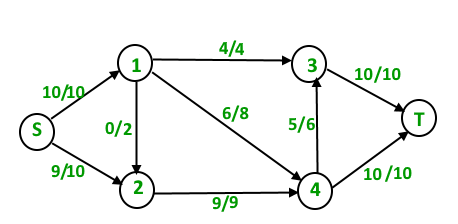
背景 :
- 最大流量问题介绍:我们介绍了最大流量问题,讨论了贪心算法并介绍了残差图。
- Ford-Fulkerson 算法和 Edmond Karp 实现:我们讨论了 Ford-Fulkerson 算法及其实现。我们还详细讨论了残差图。
Edmond Karp 实现的时间复杂度为 O(VE 2 )。在这篇文章中,讨论了一种新的 Dinic 算法,它是一种更快的算法并且需要 O(EV 2 )。
与 Edmond Karp 的算法一样,Dinic 的算法使用以下概念:
- 如果残差图中没有s到t路径,则流是最大的。
- BFS 在循环中使用。尽管我们在两种算法中使用 BFS 的方式有所不同。
在 Edmond 的 Karp 算法中,我们使用 BFS 来查找增广路径并通过该路径发送流量。在 Dinic 的算法中,我们使用 BFS 来检查是否有更多的流是可能的,并构建水平图。在级别图中,我们为所有节点分配级别,节点的级别是节点到源的最短距离(就边数而言)。一旦构建了级别图,我们就使用此级别图发送多个流。这就是它比 Edmond Karp 工作得更好的原因。在 Edmond Karp 中,我们只发送通过 BFS 找到的路径发送的流。
Dinic 算法概述:
1) Initialize residual graph G as given graph.
1) Do BFS of G to construct a level graph (or
assign levels to vertices) and also check if
more flow is possible.
a) If more flow is not possible, then return.
b) Send multiple flows in G using level graph
until blocking flow is reached. Here using
level graph means, in every flow,
levels of path nodes should be 0, 1, 2...
(in order) from s to t.如果无法使用级别图发送更多流,则流是阻塞流,即不存在更多路径,因此路径顶点按顺序具有当前级别 0、1、2……。阻塞流可以看作与此处讨论的贪心算法中的最大流路相同。
插图 :
初始残差图(与给定图相同)
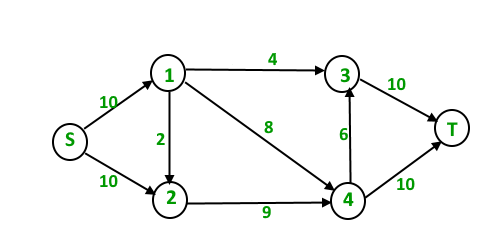
总流量 = 0
第一次迭代:我们使用 BFS 为所有节点分配级别。我们还检查是否可能有更多的流量(或者残差图中有一个 st 路径)。
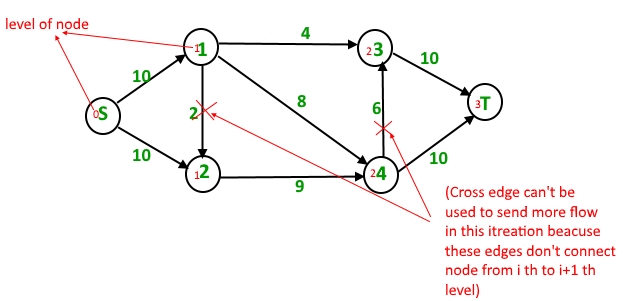
现在我们使用级别找到阻塞流(意味着每个流路径的级别应该为 0、1、2、3)。我们一起发送三个流。与我们一次发送一个流的 Edmond Karp 相比,这是优化的地方。
路径 s – 1 – 3 – t 上的 4 个单位流量。
路径 s – 1 – 4 – t 上的 6 个单位流量。
路径 s – 2 – 4 – t 上的 4 个单位流量。
总流量 = 总流量 + 4 + 6 + 4 = 14
一次迭代后,残差图变为以下。

第二次迭代:我们使用上述修改残差图的 BFS 为所有节点分配新级别。我们还检查是否可能有更多的流量(或者残差图中有一个 st 路径)。
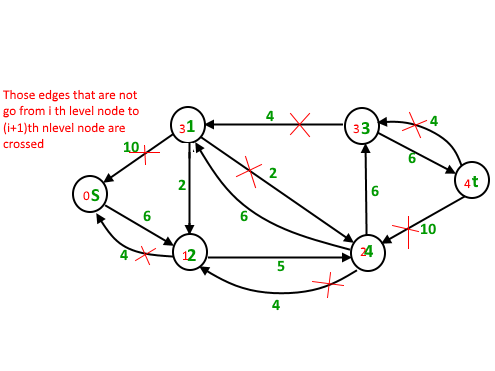
现在我们使用级别找到阻塞流(意味着每个流路径的级别应该为 0、1、2、3、4)。这次我们只能发送一个流。
路径 s – 2 – 4 – 3 – t 上的 5 个单位流量
总流量 = 总流量 + 5 = 19
新的残差图是
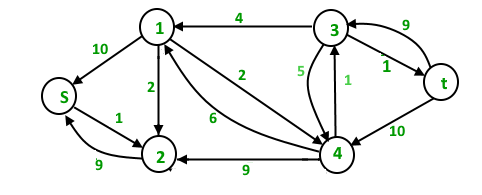
第三次迭代:我们运行 BFS 并创建一个级别图。我们还会检查是否有更多流量,并且仅在可能的情况下继续。这次残差图中没有 st 路径,所以我们终止算法。
执行 :
下面是 Dinic 算法的 c++ 实现:
CPP
// C++ implementation of Dinic's Algorithm
#include
using namespace std;
// A structure to represent a edge between
// two vertex
struct Edge
{
int v ; // Vertex v (or "to" vertex)
// of a directed edge u-v. "From"
// vertex u can be obtained using
// index in adjacent array.
int flow ; // flow of data in edge
int C; // capacity
int rev ; // To store index of reverse
// edge in adjacency list so that
// we can quickly find it.
};
// Residual Graph
class Graph
{
int V; // number of vertex
int *level ; // stores level of a node
vector< Edge > *adj;
public :
Graph(int V)
{
adj = new vector[V];
this->V = V;
level = new int[V];
}
// add edge to the graph
void addEdge(int u, int v, int C)
{
// Forward edge : 0 flow and C capacity
Edge a{v, 0, C, adj[v].size()};
// Back edge : 0 flow and 0 capacity
Edge b{u, 0, 0, adj[u].size()};
adj[u].push_back(a);
adj[v].push_back(b); // reverse edge
}
bool BFS(int s, int t);
int sendFlow(int s, int flow, int t, int ptr[]);
int DinicMaxflow(int s, int t);
};
// Finds if more flow can be sent from s to t.
// Also assigns levels to nodes.
bool Graph::BFS(int s, int t)
{
for (int i = 0 ; i < V ; i++)
level[i] = -1;
level[s] = 0; // Level of source vertex
// Create a queue, enqueue source vertex
// and mark source vertex as visited here
// level[] array works as visited array also.
list< int > q;
q.push_back(s);
vector::iterator i ;
while (!q.empty())
{
int u = q.front();
q.pop_front();
for (i = adj[u].begin(); i != adj[u].end(); i++)
{
Edge &e = *i;
if (level[e.v] < 0 && e.flow < e.C)
{
// Level of current vertex is,
// level of parent + 1
level[e.v] = level[u] + 1;
q.push_back(e.v);
}
}
}
// IF we can not reach to the sink we
// return false else true
return level[t] < 0 ? false : true ;
}
// A DFS based function to send flow after BFS has
// figured out that there is a possible flow and
// constructed levels. This function called multiple
// times for a single call of BFS.
// flow : Current flow send by parent function call
// start[] : To keep track of next edge to be explored.
// start[i] stores count of edges explored
// from i.
// u : Current vertex
// t : Sink
int Graph::sendFlow(int u, int flow, int t, int start[])
{
// Sink reached
if (u == t)
return flow;
// Traverse all adjacent edges one -by - one.
for ( ; start[u] < adj[u].size(); start[u]++)
{
// Pick next edge from adjacency list of u
Edge &e = adj[u][start[u]];
if (level[e.v] == level[u]+1 && e.flow < e.C)
{
// find minimum flow from u to t
int curr_flow = min(flow, e.C - e.flow);
int temp_flow = sendFlow(e.v, curr_flow, t, start);
// flow is greater than zero
if (temp_flow > 0)
{
// add flow to current edge
e.flow += temp_flow;
// subtract flow from reverse edge
// of current edge
adj[e.v][e.rev].flow -= temp_flow;
return temp_flow;
}
}
}
return 0;
}
// Returns maximum flow in graph
int Graph::DinicMaxflow(int s, int t)
{
// Corner case
if (s == t)
return -1;
int total = 0; // Initialize result
// Augment the flow while there is path
// from source to sink
while (BFS(s, t) == true)
{
// store how many edges are visited
// from V { 0 to V }
int *start = new int[V+1] {0};
// while flow is not zero in graph from S to D
while (int flow = sendFlow(s, INT_MAX, t, start))
// Add path flow to overall flow
total += flow;
}
// return maximum flow
return total;
}
// Driver Code
int main()
{
Graph g(6);
g.addEdge(0, 1, 16 );
g.addEdge(0, 2, 13 );
g.addEdge(1, 2, 10 );
g.addEdge(1, 3, 12 );
g.addEdge(2, 1, 4 );
g.addEdge(2, 4, 14);
g.addEdge(3, 2, 9 );
g.addEdge(3, 5, 20 );
g.addEdge(4, 3, 7 );
g.addEdge(4, 5, 4);
// next exmp
/*g.addEdge(0, 1, 3 );
g.addEdge(0, 2, 7 ) ;
g.addEdge(1, 3, 9);
g.addEdge(1, 4, 9 );
g.addEdge(2, 1, 9 );
g.addEdge(2, 4, 9);
g.addEdge(2, 5, 4);
g.addEdge(3, 5, 3);
g.addEdge(4, 5, 7 );
g.addEdge(0, 4, 10);
// next exp
g.addEdge(0, 1, 10);
g.addEdge(0, 2, 10);
g.addEdge(1, 3, 4 );
g.addEdge(1, 4, 8 );
g.addEdge(1, 2, 2 );
g.addEdge(2, 4, 9 );
g.addEdge(3, 5, 10 );
g.addEdge(4, 3, 6 );
g.addEdge(4, 5, 10 ); */
cout << "Maximum flow " << g.DinicMaxflow(0, 5);
return 0;
} 输出:
Maximum flow 23时间复杂度: O(EV 2 )。使用 BFS 构建级别图需要 O(E) 时间。在到达阻塞流之前发送多个流需要 O(VE) 时间。外循环最多运行 O(V) 时间。在每次迭代中,我们构建新的级别图并找到阻塞流。可以证明,每一次迭代,层数至少增加一个(证明见下面的参考视频)。所以外循环最多运行 O(V) 次。因此总体时间复杂度为 O(EV 2 )。